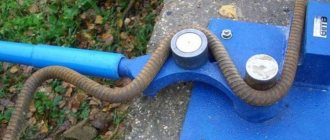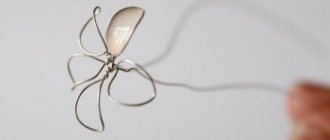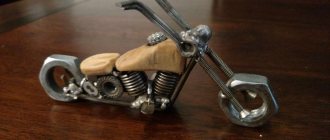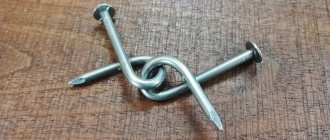It is difficult to say where products made from wire, which is a metal thread or a thin rod, have not been used today. Wire bending made it possible to give products any desired shape. Both using hand tools and mechanical influences on special equipment.
From a physical point of view, the process of bending wire consists of simultaneous compression of the inner and stretching of the outer layers of the metal of the wire. The process can also be accompanied by a longitudinal displacement of these layers if twisting occurs. This technology for working with metal wire is widely used in many industries and in jewelry.
Methods for bending metal wire
There are several main ways to give metal wire the required shape of the finished product, so we can highlight:
- manual method of bending wire using special tools and simple devices. It is used for wire with a diameter of up to 3 mm in the manufacture of simple products in utility production or households. As a rule, it does not require virtually any financial investment or special knowledge;
- manual method of making jewelry from wire up to 2 mm in diameter. Requires special tools and devices, as well as certain knowledge and skills for working with precious metals;
- bending wire from a coil, which is based on a special device called an unwinder;
- bending wire from a metal rod;
- bending using wire rolling method;
- bending metal wire using the pushing method.
Homemade manual machine for artistic wire bending
In order to bend wires to create metal patterns on fences, stair railings, and for decorating facades, special factory-made equipment is used.
However, it is also possible to independently manufacture such a device.
Rice. 1
Rice. 2
Brief manufacturing steps:
- Make a frame (2) measuring 150x80 mm from a steel plate 30 mm thick.
- A through hole is drilled at the end of the frame (visible in Fig. 1) for the adjusting bolt, blind holes (2) and (3) for fixing the rollers, (4) and (5) for fixing the frame to the corner. The holes are threaded with M8 threads.
- An unequal angle 60x40 mm with a shelf thickness of 5 mm and a length of 200 mm is screwed to the table.
- For the groove in Fig. 1, a steel block 90 mm long is made. A blind hole with a thread (1) for the adjusting bolt, a through hole (2) for fixing the rotation angle adjustment knob, a hole (3) 10 mm deep with an M8 thread for a roller with a corrugated surface are drilled in the block.
- The assembled frame (2) with guide rollers (3), two handles (5) and (6), and a roller with a grooved surface are screwed to the corner.
Wire bending machines
Mechanical machines for the mass production of parts and finished products from metal wire are widely used in industrial production. Depending on the technology used to shape the finished product, there are:
- A wire bending machine that produces parts directly from a coil. It is the most productive and economical option for mass production of wire products.
This happens due to the fact that the coil of wire is installed in a special device - an unwinder, from which the metal thread enters the correct block. There it is exposed to a roller or plane mechanism, as a result of which the output takes the form of an even and straight rod. After this, the wire enters the bending unit of the machine, where, with the help of mechanical devices, it is given the required shape of the finished product. At the end of the process, the finished part is cut with mechanical scissors. Typically, such a wire bending machine can produce one type of finished product, which is determined by pre-installed mechanical devices and limited by the ability to manipulate the feed mechanism. Therefore, the shapes of products produced on such machines are not very complex in configuration, since the number of bending operations is limited to five. - A wire bending machine for bending wire from a metal rod is a more technologically advanced method, which has a number of advantages compared to working from a coil. This is especially necessary when the finished product requires additional processing. This can be threading or stamping, which can only be done until the finished product is shaped. The disadvantages of such a machine are its need for an additional complex mechanism for feeding workpieces and relatively low overall productivity.
- The wire bending machine for bending wire using the rolling method is mainly used for the production of various round-shaped parts and various types of round springs. For example, such a machine for bending wire by rolling works due to the fact that the wire is fed through guide rollers onto a shaft of a given radius, where, due to its rotational movement, it bends around the finger a given number of times. In this case, the wire is twisted along a given radius, which has a bending finger and rolling rollers. Due to the position of the rolling rollers relative to the central shaft, the bending angle or spring pitch can be set and adjusted. A wire bending machine by rolling, like other similar mechanical devices, is capable of producing only one type of product per operation. To change the range of products, both the replacement of bending devices and commissioning work are required.
- Wire bending machine for bending metal wire using the pushing method.
For certain wire parts, during their manufacture, it is necessary to give them complex shapes of certain geometric shapes, such as variable radii, irregular arcs, spiral appearance, and the like. It is not very effective to do this by running in, and sometimes it is even technologically impossible. Hence, the only possible way is to use the wire pushing method. The principle of operation is the forward movement of metal wire through a three-roll roll forming unit or a special spring-coiling device, in which the shape of the finished product is given due to the position of the rolling rollers. As a result, you can obtain any given curvature or a smooth change in the size of the radius. The main difference between rolling and other bending methods is that the equipment is more complex, requiring special knowledge during setup and maintenance. - Straightening machines are used as an additional device in technological lines for the production of various metal wire mesh for straightening the wire and giving it a certain shape. Two technologies are used here: straightening using the rotation method using a frame and straightening using a two-plane straightening block. The two-plane block does not straighten very perfectly, but it does not twist the wire. But the rotating straightening frame has a more complex design, but many machine tool manufacturers still prefer it to the classic straightening block design.
CNC machines
The development of machine tool construction has made it possible to produce wire bending machines with one or two bending consoles.
They can produce finished products not only in flat 2D shapes, but also in spatial 3D models. The transfer of control of production processes to an industrial computer made it possible for a CNC machine to rotate bending consoles in three-dimensional space in any given sequence. Wire bending with CNC machines not only allows for higher productivity, but also allows for the production of products of different shapes just by changing the production program.
Do-it-yourself wire bending devices
Metal wire, or rather, various products made from it, is widely used in any household.
Bending wire with your own hands using hand tools allows you to produce a fairly large number of household products, such as:
- clamps,
- brackets,
- hangers, etc.
But for this we have to use the softest and most flexible types of wire, so that we can easily bend the metal into the shape we need.
So, for working with wire up to 3 mm in diameter, round nose pliers, pliers and a bench vice are suitable, and you can cut the wire with wire cutters or side cutters. This set is quite enough to give the metal wire the desired shape and its subsequent processing.
Working with large diameter wire has certain difficulties. But if it is also rigid, then to bend it manually you will need to use special bending devices.
Of course, you can buy a ready-made bending device, but it’s quite possible to make the tool yourself. How to make a device for bending wire with your own hands from available parts can be seen in the photo.
What is used for bending wire? How to make a machine with your own hands!
Objects of various configurations and purposes can be made from wire. During work, it is important to bend the material correctly, therefore, when the diameter of the metal thread is more than 1 mm, it is advisable to use special devices.
The main types of this type of tool, as well as how to make a wire bending machine with your own hands, will be discussed in this article.
Basic bending methods
If it is necessary to perform a small amount of work, then hand tools are used to bend the wire. For bending soft metal materials or when the wire diameter does not exceed 3 mm, pliers or round nose pliers are used. These tools allow you to securely clamp a part of the product in one tool, and use another to bend the wire to the desired angle.
In this way, you can bend the material using a carpenter's vice. In this case, the wire is fixed in a vertical position, and the change in direction is also carried out using pliers or any other clamping device or mechanism.
If it is necessary to make a rounded bend, then for this purpose any rod of suitable diameter is used, which is also clamped in a vice. A rounded bend will need to be made when making springs from elastic wire yourself.
To do this, it is enough to clamp a rod or pipe of a suitable diameter in a vice, fix the end of the wire on one side, and use pliers to wind the wire the required number of turns.
If the wire has to be bent too often, then the most correct solution would be to purchase special devices or machines.
Tools for bending this material are a design in which the wire is clamped and bent using human muscle power. Machine tools usually use electric drives, and for the manufacture of complex products such machines are equipped with electronic controls.
Rules for work
Wire bending is not a complicated process, but to work effectively with this material you must adhere to the following rules:
- For work, you must use gloves made of thick fabric.
- Use only working tools and automatic machines.
- If a vice is used to perform this operation, then before starting the process, you must make sure that the workpiece is securely fixed.
- Before bending, the workpiece should be leveled.
Following these recommendations will help prevent scraps and injuries in the event of a sudden release of material from the holding device. You should also take care of the wiring and proper grounding when using machines that run on electricity.
Equipment use
If the volume of work is large enough, then equipment equipped with an electric motor will allow you to perform a large number of operations. The use of machines will significantly increase labor productivity, but at the initial stage it will be necessary to make some efforts to study the process of operation of a wire bending machine.
The most economical machine for bending wire is considered to be coil equipment, in which the material is supplied from bulk coils.
The process of bending wire on such equipment is carried out in the following order:
- The wire from the coil is fed to a roller mechanism, which aligns the material.
- The straightened wire enters the bending mechanism.
- At the next stage, bending and separation of the wire products occurs.
- After cutting the finished product, the process is repeated.
To make wire bending work as comfortable as possible, CNC machines are used.
Despite the significant cost of such equipment, the return on investment in a business occurs within a few months. Machines equipped with a microprocessor allow not only to fully automate the process, but also to carry out welding work on curved products.
DIY device
If the wire bending device will be used only for home work, then you can make a manual machine yourself. Equipment made with your own hands will not be highly productive, but for performing daily operations in a small volume such a product will be quite sufficient.
For a homemade machine you will need to prepare the following materials:
- Sheet steel 4 mm.
- Steel rod 20 mm.
- Profile pipe 20*20 mm and 30*30 mm.
- Two 12 mm nuts.
- Steel pipe ¾.
- Bolt 12 * 70 mm.
- Bushing from the reaction rod of a VAZ 2106 car.
To perform this work you will also need to prepare the following tools:
- grinder;
- welding machine;
- drill and metal drill bit 20 mm.
A device for bending wire is made with your own hands in the following sequence:
- A rectangle measuring 150*80 mm is cut out of a steel sheet using a grinder.
- Stepping back approximately 30 mm from the shorter side, you need to make a hole with a diameter of 20 mm exactly in the middle.
- Cut a piece 45 mm long from the metal rod.
- Place a piece of rod into the previously made hole and weld it on the back side.
- Cut a 70*30 mm rectangle from a metal sheet.
- Make two holes with a diameter of 16 mm in the 70*30 mm plate. The holes should be equidistant from the edges of the plate, and the distance between them should be 20 mm.
- Weld M12 nuts to the 70*30 mm plate so that they align with the holes made earlier. In order to perfectly center the nuts before welding, it is recommended to place them on a bolt, which should be threaded into the hole.
- Cut a piece 45 mm long from a ¾ steel pipe.
- Weld a 70*30 mm plate to the resulting cylinder made of a metal pipe, so that the pipe hole is in the same row as the previously drilled 16 mm holes. When performing this work, the plate should be placed exactly in the middle of the height of the steel cylinder.
- Cut a piece 400 mm long from a 30*30 mm profile pipe.
- Weld a section of profile pipe to a 70*30 mm steel plate. The metal connection is made on the side opposite to the welded cylinder. This will create a lever with a cylinder and 2 holes at the end.
- A piece 100 mm long is cut from a 20*20 mm profile pipe.
- A section of profile pipe is welded to the edge of a 150*80 mm plate. This element must be positioned from one of the corners to the level of the previously welded metal rod.
- Cut a 70*40 mm plate from a metal sheet. This part will be intended to support the workpiece, so it must also be welded to a section of the profile pipe.
- The torque bushing fits onto a 12 mm bolt, which should then be screwed into a nut welded to the lever.
- The lever with the bushing is fitted as a cylinder onto a piece of metal rod welded to the frame.
- To securely fix the machine during operation, it is recommended to secure the frame to a flat horizontal surface using threaded connections or welding.
The manufacture of the machine can be considered completed.
Wire bending is carried out as follows:
- The workpiece is placed on the side platform so that the front part is inserted into the gap between the central cylinder and the bushing attached to the lever.
- The lever rotates to the required angle.
- The workpiece is removed from the machine, trimmed and used for its intended purpose.
If the homemade machine was made of high-quality materials, and the welding seams were made at a professional level, then the device can be used not only for processing wire. In this case, it is possible to use the product for bending pipes, including profile pipes, with a diameter of up to 10 mm.
Watch the video where a man shows how to assemble a simple structure of a reinforcement bender for bending rods and squares:
The second video shows an overview of the mechanism for bending wire and curling hooks:
Conclusion
What is used for bending wire is described in detail in the article. To work with this material, you can use both simple tools and complex installations that allow you to perform a large number of operations per minute.
If you have a limited budget, you can independently make a mechanical device that will not be inferior in quality to factory products.
How to bend wire into a ring evenly
In order to bend the wire into a ring and make it the correct shape, you must use either a pre-made wooden blank of the required diameter, or use a piece of metal pipe of a suitable diameter.
We wind at least two turns onto the template and make marks, while not forgetting to allow for the thickness of the cut. Next, cut the wire and weld an even ring. If anyone knows other ways to make complex shapes from wire, you can share them in the comments block.
Main stages of work
First of all, we screw the bolt into the nut, after which it is necessary to drill a through hole using an electric drill, holding the workpiece in a vice, or on a drilling machine. It is important to ensure that the steel does not overheat. Therefore, you will first need to drill a hole with a small drill, and then with a large one.
Then, using an angle grinder with a cutting disc, cut about ½ off the top of the hex nut. To do this, you must first mark the surface with a marker.
Then certain manipulations will need to be done with the bolt itself - for this you can use either a grinder or a drill.
At the last stage of work, we weld a handle made of a hollow steel tube to the nut (or you can use a round rod of a suitable diameter). The process of making a homemade product can be seen in the video on the website.
Useful Manual Mini Bender











